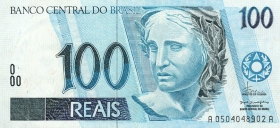Specifics of Brazilian Real Explained

Historical Facts About the Brazilian Real
In 1500, Brazil was established as a colony of Portugal, and its currency was given the name “Real”. Like many other countries, the Real was linked traditionally to the gold standard; however, in 1871 the system was universally abandoned. The current incarnation of the Real was launched just a few years after the re-establishment of a democratic government in Brazil, following the ruling of the country by a military regime during the 1960s and 1970s. It was issued with the hope of maintaining stability in the currency due to the long ongoing period of hyperinflation that the country was experiencing.
1989 saw a full return to democracy, but it was difficult for the government to cope with the economic chaos in the wake of the previous military and transitional governments. One way in which President Fernando Collor attempted to stabilise the economy was to open the country to greater investment and foreign trading opportunities. After Collor was impeached due to public dissatisfaction in 1992, the successive government formulated an initiative to launch a new currency. When the Real was launched in 1994 it initially maintained parity with the USD by using a crawling peg system whereby the Brazilian Real could float against other international currencies within a band of a few centavos. In 1999, the Real began to float freely against the US Dollar, and was devalued by more than 20%.
Facts About the Brazilian Economy
Brazil ranks seventh in the world in terms of its GDP. It has a diversified economy, being a key producer of industrialised products and commodities. Some of the most important manufactured goods produced in Brazil include car parts and automobiles, equipment and machinery, cement, textiles, aircraft, computers, petrochemicals, consumer durable goods and steel. Industry is responsible for over 25% of Brazil’s total GDP, and is the source of employment for around 19% of the country’s workforce. Brazil also produces numerous important commodities such as iron ore, oil, soy beans, corn, cotton, sugar, cocoa, forest products and livestock. Brazil trades primarily with China, the United States, Argentina, Japan and the EU.
The economy of Brazil is the biggest of all of the Latin American countries and also the second biggest in the western hemisphere. Brazil was still one of the world’s fastest growing economies until 2012; however, deceleration occurred in 2013, and Brazil’s economy went into recession in 2014. The largest component of Brazil’s GDP is the country’s service sector, which represents 67% of the GDP. Agriculture is also important, representing 5.5% of the GDP. 71% of Brazil’s labour force work in the service sector, with 10% of workers being employed in the agricultural sector.
Important Indicators for the Brazilian Real Forex Market
There are several important economic indicators that any trader keen to trade the Brazilian Real should pay attention to. These include the following:
- The Indice Bovespa – This is the primary indicator of the BM&FBOVESPA (formed from the merger of the Brazilian Mercantiles and Futures Exchange and the São Paulo Stock Exchange). The gross total return weight index follows the fifty most popular stocks for trading on the São Paulo Stock Exchange.
- GDP – As with all other countries, Brazil’s GDP is an important indicator, providing an accurate measurement of economic health in Brazil.
- Exports and commodities – Brazil is a major exporter of sugar, coffee and orange juice, and it is important to follow the balance of imports and exports closely.
- Brazil’s economy relies heavily on exports, and therefore the monthly industrial production and manufacturing purchasing manager index is an important indicator.
- Remittances – This is money that has been sent to Brazil from citizens who work abroad.
- Unemployment figures
- CPI reports and monthly inflation rate reports
- Government total expenditure – A large number of workers in Brazil work for the government.







